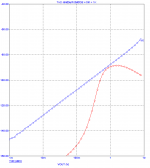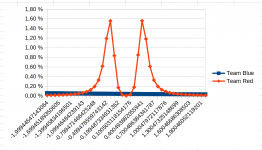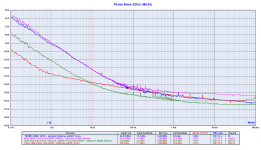When it comes to sound quality vs measurements, one internet site which I think about is goldenears.net, or goldenears.ko. They're not active anymore.
They used to upload the frequency response measurements of all kinds of IEM's & headphones, really a lot, like more than 100, or 200.
They just posted the FR, every time I went to check a product it was just the FR with some subjective comments & a little subjective graph underneath.
I think with the dual, triple & six BA drivers, there is nothing at all in the FR showing the sound difference. A single driver can be theoretically flat from 100 Hz to 15 kHz, six drivers can be theoretically flat from 100 Hz to 15 kHz, there is no visual difference in the measurement data at all.
They used to upload the frequency response measurements of all kinds of IEM's & headphones, really a lot, like more than 100, or 200.
They just posted the FR, every time I went to check a product it was just the FR with some subjective comments & a little subjective graph underneath.
I think with the dual, triple & six BA drivers, there is nothing at all in the FR showing the sound difference. A single driver can be theoretically flat from 100 Hz to 15 kHz, six drivers can be theoretically flat from 100 Hz to 15 kHz, there is no visual difference in the measurement data at all.
I never have Dover sole Bill and not all of our dish is spicy either. But we like to use hot sauce in many of western style dishes like grilled seafood, hamburger, hot dog, steaks and soups similar to Americans use ketchup. For me and a few hundred million living in this region, the analogy is passable enough. We know perfectly well that not everyone can eat our favorite spicy food, some who tried did require hospital care. Similarly some people balk at a 0.1% THD amp while others sing praises to the 0.7% types (albeit we know almost nothing to measured acoustic parameters). For the warriors it's a good enough reason to continue the dogfight, but a few on the sideline could not help the feeling that the fight is somewhat unreal.A very spicy Dover sole is not an accurate rendition of the dish. Poor analogy in this context...
My level of preference is about the equivalent of finely ground fresh 2-3 ripe habaneros paste on a quarter pounder hamburger, some younger friends like about 5, a few even want 10-12. For us, the spicy after taste usually last for a few minutes, then back to normal. Probably I need to cut back, the doctors cautioned on my hereditary colon bleeding.You mean it won't if you are used to it?
Andrea_mori, I think you are on a positive track
You say this to a man slavishly devoted to a single measurement. The irony...
You say this to a man slavishly devoted to a single measurement. The irony...
Since as usual you don't read carefully let me recall:
"After several years the oscillators project is ended since we have reached the prefixed target.
Now we are working on the digital front end and on the DAC.
Then we will work on the amp and the speakers (although I have already got the drivers)."
"I thought I was clear when I wrote that we are developing the whole system.
The only part we have completed is the oscillator for the digital to analog conversion.
We have measured it using one of the most suitable tool available today (so we have invested in the modern equipment capable of supporting our claims and you should know it's very expensive) and we have drawn the conclusion: we have designed a state of the art device, one of the best oscillators on the whole market (by mesurements comparison)."
Have you understood now?
The only completed design of the system is THE OSCILLATOR.
What kind of measures should I perform for an oscillator?
Do you know an oscillator is not an amplifier and neither a DAC?
It looks like you don't know, but since I'm here to learn, please let me know what measures I should perform.
And please let also know Wenzel and Oscilloquartz they are performing the wrong measurements.
Then, since you will write the same thing again, now we are working on the digital front end, a FIFO buffer to be precise.
We are performing the same kind of measurements, we are measuring the phase noise of the I2S/PCM clock signals like BCK and LRCK, like in the attached plot.
If you believe we are performing the wrong measurement please let us know what measures we should perform.
After the digital front end we will work on the DAC, on the amplifier and on the speakers.
Let me recall what Chris suggested in a previous post:
"buy a good bench meter with AC response out to at least 100 KHz, or 300 KHz like the current bench meters (like Keysight)"
I own a Keithley 2001, 7 1/2 digits, AC response up to 2MHz.
Is it a useful tool? Or do you think I have to replace it?
I also own the QA401 (suggested from Demian Martin), do you think I have to throw out it?
Finally the speakers.
I own the Clio Pocket measurement setup, do I have to replace this too?
And now please let me know about your wonderful tools which will surely be better than mine.
Attachments
Sorry, but I have not yet understood the relationship.
Let me try to explain why you think the tube amp was more like live sound than the low distortion LM3886 (which is not the right amp to compare with a tube amp)...
Low THD is not 100% sufficient to describe amplifier's ability to reproduce input signal. And there is no guarantee that a recording should sound like the original sound, as the microphones are usually placed at different locations than ears usually are.
Most amps and especially speakers remove (and add) some low level information from the input signal (which unfortunately not everyone can hear). I think tube amps can retain some of this information that is missing but mostly it can reproduce this missing information along with distortion. Either the missing information is there because the distortion is not removed, or the distortion itself creates this sense of completeness in the sound.
When I listen to a high distortion class-A amps like Hiraga 30W or even Pass Lab's F5 (which is lower in distortion than the Hiraga) I can hear more information especially the room ambience but my question is, is it in the recording? I still believe that my CFP amp is more accurate.
@johnego,
It is well known in the recording industry that room sound can be brought up relative to other sounds by the use of dynamics compression (e.g. Empirical Labs Distressor). A sense of dynamics can be retained by using slow attack, and fast release times.
Other than that, I am not understanding how room sound could be brought up in relative level, or else somehow synthesized by a high distortion amplifier.
Seems more likely to me the sound is getting lost in high gain amplifiers. This opinion is partially based on listening impressions.
A recent experiment involved minor audio opamp rolling in the I/V conversion section of Rohm BD34301EKV eval board. Room sound was most audible with NE5532, less so with OPA1612 and OPA1656. Audible distortion was higher with 5532.
Its hard to understand how room sound can to various degrees present or missing by such a simple change, but there must be some physical explanation beyond blaming it all on human hallucination.
EDIT: Just recalled there is some anecdotal evidence that room sound on master tapes is more audible than is reproduced by some low-measured distortion DACs. Unfortunately the quandary has never been studied in a serious scientific way.
It is well known in the recording industry that room sound can be brought up relative to other sounds by the use of dynamics compression (e.g. Empirical Labs Distressor). A sense of dynamics can be retained by using slow attack, and fast release times.
Other than that, I am not understanding how room sound could be brought up in relative level, or else somehow synthesized by a high distortion amplifier.
Seems more likely to me the sound is getting lost in high gain amplifiers. This opinion is partially based on listening impressions.
A recent experiment involved minor audio opamp rolling in the I/V conversion section of Rohm BD34301EKV eval board. Room sound was most audible with NE5532, less so with OPA1612 and OPA1656. Audible distortion was higher with 5532.
Its hard to understand how room sound can to various degrees present or missing by such a simple change, but there must be some physical explanation beyond blaming it all on human hallucination.
EDIT: Just recalled there is some anecdotal evidence that room sound on master tapes is more audible than is reproduced by some low-measured distortion DACs. Unfortunately the quandary has never been studied in a serious scientific way.
Last edited:
Damn, no-one took my little quiz. I'll add one more hint.
On THD vs output level, red circuit looks good...

Measuring THD vs DC offset gives a completely different picture.

I've never seen anyone do this measurement. Intermodulation is similar, but it does not reveal the circuit's problem in the same explicit way.
On THD vs output level, red circuit looks good...

Measuring THD vs DC offset gives a completely different picture.

I've never seen anyone do this measurement. Intermodulation is similar, but it does not reveal the circuit's problem in the same explicit way.
Other than that, I am not understanding how room sound could be brought up in relative level, or else somehow synthesized by a high distortion amplifier.
A pure note without distortion will sound "sharp". A note with 2nd order distortion will sound "wider" giving the sense of room ambience.
Seems more likely to me the sound is getting lost in high gain amplifiers. This opinion is partially based on listening impressions.
I'm sure about this. But it doesn't mean that high gain is the cause.
Room sound was most audible with NE5532, less so with OPA1612 and OPA1656. Audible distortion was higher with 5532.
An opamp is a complex amplifier.
.. I think tube amps can retain some of this information that is missing ....
Wow - magic... toobe amps can recreate missing information... read all about it!!!
LOL
Re-Fi... Restored Fidelity...
(Sorry!!)
//
Much simpler than that...
Why the guessing game? What you have is interesting but I would rather cut to the chase and have the rest of the story.
But also important are the IMD results.
Hi Chris, what fundamental frequencies did you find more critical (any reason for that)?
Wow - magic... toobe amps can recreate missing information... read all about it!!!
LOL
Hehehe it's not the TRUE or FALSE that show people intelligence, its the logic.
Let me try to explain why you think the tube amp was more like live sound than the low distortion LM3886 (which is not the right amp to compare with a tube amp)...
Low THD is not 100% sufficient to describe amplifier's ability to reproduce input signal. And there is no guarantee that a recording should sound like the original sound, as the microphones are usually placed at different locations than ears usually are.
Most amps and especially speakers remove (and add) some low level information from the input signal (which unfortunately not everyone can hear). I think tube amps can retain some of this information that is missing but mostly it can reproduce this missing information along with distortion. Either the missing information is there because the distortion is not removed, or the distortion itself creates this sense of completeness in the sound.
When I listen to a high distortion class-A amps like Hiraga 30W or even Pass Lab's F5 (which is lower in distortion than the Hiraga) I can hear more information especially the room ambience but my question is, is it in the recording? I still believe that my CFP amp is more accurate.
While I (and all the other participants to the listening session) still believe that the 845 amp sound is more realistic than the sound from the LM3886 amp.
The reason does not matter much since the final result is clear.
And the result was the same with all the recording we have listened to (classical, jazz, acoustic, no electronic music at all).
All the participants to the listening session used to attend to live events, one of them is a piano teacher, I use to play piano as an hobby.
The other participants like music but they don't know anything about audio.
Nothing to do with personal taste, they all did look for the more realistic as possible reproduction.
They are all able to recognize the difference between one piano over another when listening to it at a live event.
They all recognized the piano brand even listening to the recording with both amplifier.
They didn't know what amplifier was working during the listening session, practically they don't know what is an amplifier.
At one point the piano teacher exclaimed something like this:
"oh... what kind of piano Daniel Baremboim is playing?! I'm sure he plays Steinway grand piano only in live concerts, but this Steinway, has something wrong!"
We were listening to the LM3886 amp in that moment.
The system was built for a friend who was present at the listening session, so I told her:
"This is the system I have built for you".
And the reply was:
"But I don't want this, I want what we heard before"
So I should have told them they were wrong because the system with the LM3886 based amp measures much better?
So I should listen to a system which gets me tired after ten minutes?
No, I don't think so.
And now please don't ask me to explain the reason because all the people did prefer the 845 based amp.
I have no explanation and mostly I'm interested less than zero on understanding the reasons.
Between an amplifier that I listen to with pleasure even if it measures worse and another that measures much better but tires me after ten minutes, I will always choose the first.
Regardless of the measurements.
I forgot, my mind is open, I measure and then I listen to.
The closed mind is that of one who measures only.
Last edited:
While I (and all the other participants to the listening session) still believe that the 845 amp sound is more realistic than the sound from the LM3886 amp. The reason does not matter much since the final result is clear.
One problem here is you are comparing with an LM3886 (And may be it is even the standard version). May be you haven't heard enough? If you listen to high distortion Hiraga 20/30W I believe you will like it more than the LM3886.
If you want to hear details, accuracy, liveliness in a low distortion class-B amplifier, try to build a good CFP amplifier (and the speaker should be detailed too, preferably electrostatic). In CFP amp you will find an example where crossover distortion is not fully correlated with THD.
My point here is, you need to have a system that doesn't change the signal like most non-tube amps do, then you will question the unnecessary distortion that comes with tube amps or class-A amps like the Hiraga.
But still, class-A and tube amps tend to be less tiring. I'm afraid this is an intermitten oscillation beyond the audio frequency that gets into the audio band.
So I should listen to a system which gets me tired after ten minutes? No, I don't think so.
I feel the same thing. But my problems are due to: (1) Small area of woofer cone trying to produce low frequencies (2) A transparent system that shows distortion that is in the recording.
Actually Andrea, there is a way out to rectify a gainclone issue. Joe Rasmussen has a very simple but great solution shown here. Just remember to invert speaker connection since his solution use the gainclone in inverting mode.... So I should have told them they were wrong because the system with the LM3886 based amp measures much better?...
PS. Don't miss the DIY version.
Last edited:
Do you believe the speakers were not enough detailed? If so, please let me know why.
I have never heard a cone material that is more natural than paper. But paper has limitation (such as the ability to produce details) that high-end drivers are not using it. High end drivers have cone that is so light made of stiff material that has unique distortion. If this drivers frequency response is not ruler flat and have to be fixed with passive components, trust me the chance to make it "worse" is high.
But LM3886 is an LM3886. It is cheaper than one resistor usually found in a DIY tube amp.
- Status
- Not open for further replies.
- Home
- Member Areas
- The Lounge
- Sound Quality Vs. Measurements
